As markets in traditional regions of automotive manufacturing contract, new plants being built in low-cost countries are looking to benefit from installing used equipment
While a lot of smaller manufacturing equipment is too specific in terms of safety or quality to be suitable for reuse, there are some major machine tools and equipment that can successfully reconditioned and re-deployed. Such elements include conveyors, robots, presses and paintshops.
Conveyors – a feast of flexibility
Introduced in 2004, the FAStplant modular final assembly system from Dürr has proved itself over a wide range of applications, ranging from automotive test plants to series passenger car production and motorcycle manufacture.
Mercedes-Benz was the first OEM to use the system, introducing a six-module pilot plant at its Sindelfingen facility in Germany in 2004. Further test plants followed for Toyota at Valenciennes (France), Ford at Cologne and Volkswagen at Zwickau (both in Germany).
Relocation, relocation, relocation
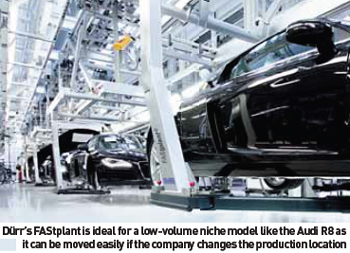 Daimler, the first FAStplant customer, went on to relocate its system three times within a period of six years – the setup is currently being used in its fourth location.
Daimler, the first FAStplant customer, went on to relocate its system three times within a period of six years – the setup is currently being used in its fourth location.
Other carmakers using the FAStplant system include BMW and Audi, the former producing cars at its CKD plant in Chennai, India, since 2007. Audi, on the other hand, is using the system to build the R8 sports car at its plant in Neckarsulm, Germany. The first mass-production chassis line to use the FASplant system, which included 80 individual modules with 58 infinitely-adjustable hangers, was built by General Motors at San Luis Potosi, Mexico. Since 2009, the plant has produced 100,000 vehicles per year.
The Tata Nano was originally planned to be produced in Singur, near Kolkata, West Bengal. Dürr was contracted to build a lean, yet quality-focused paintshop for the facility. But before production could start, Tata had to find a new location for the plant and move the entire operation, an exceptional order that the Indian carmaker also placed with Dürr.
Facing massive local opposition, the decision was made to move the plant from Pantnagar to Sanand, near Ahmedabad, in Gujurat. At that point, almost 40% of the paintshop had already been installed. Responding to the challenge, Dürr managed to relocate the half-built paintshop over a period of only five months. While this is not exactly reused equipment, it certainly demonstrates that even paintshops can be moved to more advantageous locations.
The remit for the new paintshop was to create a ‘good value for low money’ installation that used the latest lean processes to deliver cost-effective and environmentallyfriendly operation. Targets included a 25% reduction in CO2 output and a 30% reduction in energy consumption compared to a standard paintshop.
Having entered operation in early 2010, the Sanand facility can paint 60 cars per hour. A mechanical RoDip installation is used to apply corrosion protection, after which the bodies enter one of two lines depending on the final trim level.
For the basic models, a single layer of solid paint is applied directly onto the cured e-coat, while a three-wet process is used to apply a more advanced coating on the second ‘metallic’ line. Some of the painting robots are equipped with Dürr’s Integrated Colour Changer (ICC), which substantially reduces paint consumption.
Camping out down under at Nissan
There is no place for used equipment in areas requiring operator protection or process monitoring says André Hack, Strategic Industry Manager, SICK Sensor Intelligence. “As a maker of safety gear, we are very aware that if anything goes wrong, it is our name on the sensors, etc., and that it’s us that will get the blame. Our customers will often ask us to either move installations of SICK equipment, or check that their installation has been completed safely. If it passes our inspection, we will put a green approval sticker on the sensor. Sometimes the OEM will have a department of engineers who can do the reuse, or it could be done by the integrator, such as KUKA or ABB. After this, we will come in and check everything. In the end, machine safety is the responsibility of the end customer, in our case the OEM.”
Tata also elected to install a previously used paintshop at the company’s Pune plant, producing Indica, Indigo, Indigo Manza, Indigo Marina (called the Indigo SW in export markets) and Vista models. Engineers from TAL Manufacturing Solutions, a division of Tata Motors, traveled to Australia to collect the paintshop, as Nitin Rajurkar, General Manager – Technical, recalls. “We bought the paintshop secondhand from Nissan in Australia and shipped it to Pune. TAL reconditioned and installed it. While not a simple operation, it was a very cost-effective, it saved us a great deal of money. A big team of TAL guys camped in Australia while they familarised themselves with the Nissan paintshop and then dismantled it very carefully and methodically so that it could be quickly rebuilt in Pune.”
According to Rajurkar, the paintshop helped to expand capacity from 500 to 750 units per day, later increasing to 1000upd. He adds that it was particularly challenging as the equipment has to be integrated into an existing brownfield site.
In an interview with AMS, Stefano Mussotto, Aftersales Service Director at Comau’s Robotics Business Unit explains what would be completed during a robot refurbishment
AMS: Can you tell us your opinion on re-using robots? At what point does it make more financial and practical sense to buy new instead of re-using?
SM: It is more convenient to buy new. It is very expensive to refurbish, often it’s the same cost as buying a new robot.
Also, when you consider the cost of introducing a new robot on an existing line, this can cost even more. You have to consider software, controller, robot base fittings (platforms), and FieldBus integration.
It makes sense for a customer to have reconditioning completed by us when they already have a very good line and simply want to maintain their existing robot stock. We completed a lot of robot refurbishments last year for Volvo Gent and Fiat Tychy (Poland). These are very busy plants that do not have time to introduce new robots during their short shutdown periods.
AMS: The main structure of a robot is virtually indestructible. Which parts of the mechanical systems do you typically have to recondition/replace?
SM: First, we can look at the history of the robot, whether there were any recorded failures with the unit. The robot might have worked a lot more in one axis than another and we would note this and check for wear and damage in this area. We have a checklist that we work to, looking for excessive backlash and lost motion. We analyse and change the gearbox oils and we revise the motors. If we find that the bearings are worn, then we will replace these. We also conduct visual tests for cracks. If we suspect that there is a crack, we would use a two-part penetrant dye test.
AMS: Would you change all the robot heads, wrists and arms or are the original units still good for the new tooling that may be used?
SM:Around 10% of wrists are replaced in a typical re-fit.
AMS: When you are working on a customer’s robots at its plant, how do you keep the lines moving while you re-fit robots?
SM: The first step would to supply 10 ready-reconditioned robots and take out 10 to work on at the customer’s plant.
We work on the robots in the OEM’s facility and then replace one to three robots every Sunday (or other ‘down’ day). We run a full reconditioning line at the customer’s premises but obviously we do not repaint robots there. The main driver for a customer to choose reconditioned robots is that they already have many of one type and want to stay with that type.
AMS: A new application for a reconditioned robot will need new controls and software. Will Comau try to provide a turnkey package for this?
SM: Comau is divided into several divisions. The customer would usually buy a complete line from Comau Body Welding Assembly Division. The robot division does not usually supply turnkey packages. We have not made a large sale of reconditioned robots for a start-up plant.
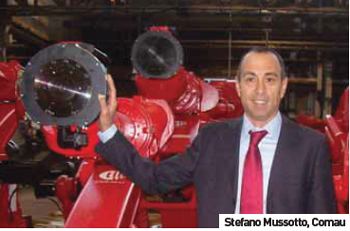 AMS: Will Comau engineers stay at the new plant with the robots to train the customer staff, and will some Comau representatives stay or re-visit when production starts?
AMS: Will Comau engineers stay at the new plant with the robots to train the customer staff, and will some Comau representatives stay or re-visit when production starts?
SM: Usually we have at least one person permanently on-site. At Volvo Gent we have one, and at the Tychy plant we have five or six people looking after the Comau robots.
AMS: How adaptable are your robots when a customer may be using Comau and another robot supplier on the same line. Can you ‘match’ Comau robots to many other suppliers’ robots?
SM: At Tychy, 99% of the robots are Comau, but they do have some older Kuka robots. We do carry out maintenance on the Kuka robots, but I personally think that each robot maker should maintain their own products, as they know them best.
At Ford Saarlouis, we have a maintenance contract for taking care of the Comau robots there, and Kuka is contracted to maintain their robots.
AMS: How much prediction, pokayoke-type TPM can be done with robots?
SM: We model a whole robot line with ‘stress analysis’ software that measures the axis usage, payload, degree of each axis, cycle times, inversions and the speeds of various operations. We provide this to our customer and advise on the inspection and maintenance schedule accordingly.
At Tychy, we implemented this and helped Fiat to cut mechanical breakdowns to zero, where in 2007, before the 500 model was introduced, Fiat had at least 20 breakdowns a year caused by robots.
AMS: Are spare robots the answer for this type of situation?
SM: Ford bought one spare robot of every type installed for Cologne, Saarlouis and Valencia. This helps cut downtime, while they also have spare control cabinets for every type of robot application. Of course it is the major mechanical parts of a robot, like gears, that cost time to repair, so spare robots are a great idea.
Kuka recently helped Mercedes-Benz recondition 500 robots, taken from the E-Class body-in-white line in Germany, where they had been in constant use for the past eight years.
In an interview with AMS January/February 2011, Frank Klein, Plant Director of Mercedes-Benz Kecskemét, said: “The 500 robots we will use have been reconditioned over the last 12 months, using industry-standard technology.” To get the robot maker’s side of the story, AMS spoke to Andreas Bauer, a director at Kuka Roboter.
AMS: Tell us a little about Kuka’s robot partnership with Mercedes-Benz, new and used?
AB: Kuka was already supplying automation lines to Mercedes-Benz in the 1960s, some time before robots became popular in automotive. Mercedes was the first automotive customer of Kuka Roboter in the late 1970s, followed by BMW. Volkswagen made its own robots at the time. The first robots supplied were for spot welding.
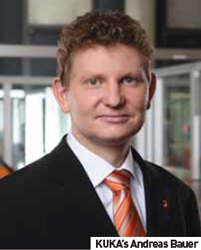 The robot is not the most expensive part of a cell; planning, conveyors, integration and the extra energy used by a previous-generation robot is all much more expensive.
The robot is not the most expensive part of a cell; planning, conveyors, integration and the extra energy used by a previous-generation robot is all much more expensive.
In the case of Mercedes-Benz Kecskemét, 500 robots meant a significant saving in capital purchase cost, but overall, only about 5% of our robots are supplied used.
AMS; Can you tell us your opinion on re-using robots? At what point does it make more financial and practical sense to buy new instead of re-using?
AB: We divide the robot system into mechanical and controller technology.
In the controller technology, things have progressed very fast with PC technology. You can use an old mechanical system and a new controller, but where you have to integrate the latest controller tech into a previous generation robot, it is theoretically possible but it is not really worth it as the latest equipment is designed to work together as one.
The new technology includes energy saving features, with more efficient motors. New generations are usually introduced every five or six years. A customer should use robots from one generation only, not mix them.
The reason robots are coming from one established plant is that this plant (Sindelfingen) wants the latest equipment and the older equipment goes to the new plant (Kecskemét).
AMS: Tell us about your used sales department and pricing?
AB: Sometimes a used robot is a better choice for the customer if they need the robot immediately. We would usually take a few days or weeks to build a new custom robot for the customer. Also, used robots are good for new customers who are introducing automation for the first time.
As an example, the same-generation robot could be up to 20% cheaper, for a previous generation robot the saving could be up to 30%. A used robot would be guaranteed for two years, the same as for a new one.
AMS: The main structure of a robot is almost indestructible. Which parts of the mechanical systems do you have to typically recondition or replace?
AB: This depends on the application, we might just change the oil, as the gears and bearings last a long time. The difference between automotive and general industry is that robots in automotive are running 24-hours a day and so will wear out long before they would in food or woodworking applications. This means the robots are replaced more frequently.
In the end, the customer must make the final decision. It may be better to sell the old robots and buy reconditioned ones that have been working in a less-taxing industry. For a new plant, standard practice is to sell old robots and replace with new. With laser or special measuring applications, new robots really are the only way to go.
As to the parts of the robot, in some older generation there are drive belts that we would change, and of course we would repaint where necessary, mainly for aesthetic reasons. We can supply spare parts for robots going back to the 1980s.
AMS: Where the robot head or other major part is changed, is it a simple process of switching the old head for a new one or do you have to work on the robot arm to make it ready for a new head?

AB: Again, this part of the robot arm is so robust that it is not necessary to change it, unless a new application is required. Of course, the tooling will be changed to suit the new application, this is what we call the ‘dress package’ and is quite routinely changed by the customer, as well as by us.
AMS: In a case like Daimler in Kecskemét, do you collect the ‘old’ robots from the customer and make all the reconditioning work at Kuka and then deliver to the new plant, or would you send Kuka engineers to the old or new plant to complete work on the robots onsite?
AB: In the case of Kecskemét, Mercedes-Benz made most of the reconditioning themselves, using Kuka spare parts.
We guarantee the performance of the spare parts but the responsibility for the reconditioning is with them. In this case, they know our robots so well that we can almost guarantee that they will be as good as if we completed the reconditioning and we are happy to provide training on rebuilding robots if necessary.
AMS: Will this package typically include PLCs and other control systems supplied by Kuka?
AB: We could supply used control cabinets with older controllers, as we would only deal in used equipment that was in very good condition, complete with our guarantee.
AMS: Will Kuka engineers stay at the new plant with the robots to train the customer staff and will some KUKA personnel stay or re-visit, when production starts?
AB: At the beginning, whether the robots are new or used, Kuka teams would be on hand, particularly for bigger lines. Once a plant is up and running, this is not necessary.
AMS; Do you sometimes find that a reconditioned robot does not perform as well as expected and so the customer must buy a new one after all?
AB: We would not sell a robot that is not 100%, as it’s important to protect our brand. We also are required by law to take responsibility for the quality and safety of the equipment.
AMS:With the developments made by Kuka in the field of lighter-weight robots, replacing heavier, older designs, is it sometimes better for the customer to replace a robot with a new lighter design?
AB:We can often recommend a newer-generation robot that has the same payload capacity, but is lighter in construction, with better stiffness and which uses less energy for the same task.
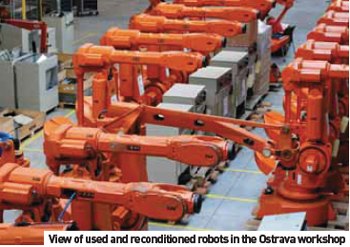 ABB has two certified robot reconditioning centres, in Ostrava, Czech Republic for European customers and in San Luis Potosi, Mexico, for customers in North America. Activities at ABB are separated into three different areas. The first is referred to as the customer property robot, which includes robots used by a customer for several years before being refurbished for use on another production line or in another plant by the same customer. Chrysler is one company that has taken advantage of this strategy, refurbishing more than 400 robots, many of which were relocated from the US to a facility in Mexico.
ABB has two certified robot reconditioning centres, in Ostrava, Czech Republic for European customers and in San Luis Potosi, Mexico, for customers in North America. Activities at ABB are separated into three different areas. The first is referred to as the customer property robot, which includes robots used by a customer for several years before being refurbished for use on another production line or in another plant by the same customer. Chrysler is one company that has taken advantage of this strategy, refurbishing more than 400 robots, many of which were relocated from the US to a facility in Mexico.
A second strategy is to replace parts on robots remaining in the same location. An example of this is currently underway at a PSA facility in Spain, which is having 170 robots refurbished. Already in place for up to 10 years, the equipment will be upgraded with the addition of new arms over a fixed period. Should the maintenance be carried out over a weekend, the robots will be ready to restart on Monday, with the old arm being returned to ABB for reconditioning.
This solution has many advantages, as it does not require any modification to the existing production cell, additional training, or spare parts, as it is fundamentally the same robot.
ABB also buys back robots for reconditioning, which includes the complete arm and controller, before reselling it as second-hand equipment, complete with warranty. The company sold more than 1,000 such robots over 2010.
The sale of used robots is primarily carried out by specialized traders such as Globalrobot (UK), Eurobot (Spain), and ICR (USA). Large auction companies such as Maynards Industries, now known as Equipment Appraisals and Auctions, also deal in large numbers of used robots.
OEMs and Tier suppliers have different criteria when looking for new-installation or replacement robots, as Stephane Chateau, Global Development Manager of Robot Reconditioning at ABB pointed out. “Some customers are looking for price only, looking for a very low cost robot, and are not too concerned with specification or guarantees.
Some are looking for reconditioned second hand robots with good technical specification and warranty package. There are definitely two types of market in this area.” Traditionally the biggest market for ABB has been the US, followed by Germany, UK, Spain, Sweden, and France, with the Benelux group of countries being the largest group area, but as Stephane Chateau says: “The demand in Eastern countries is growing fast, but Asia is a very small market; only some countries like India, Vietnam, and Korea show some interest. There is less demand due to local importation and tax regulations on used machinery.”
According to Chateau, used robots can also help ‘peak shave’ heavy demand, when robot makers simply cannot make enough new machines. “For ABB, one of the key drivers during 2010 was the availability of robots, due to the high demand of new machines, the delivery times for all robot manufacturers were well behind market demands.
Having reconditioned robots in stock was a key element to helping some customers meet their schedules.”
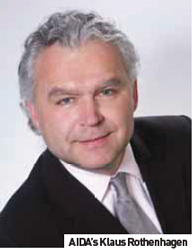 When building new presses, one of the major expenses is the sheer volume of heavy castings and other iron and steel work involved, meaning that reuse is a suitable option. This, though, brings special challenges. How do you recondition and transport something so enormous as a five-tonne body part press? When does the cost of transport become prohibitive?
When building new presses, one of the major expenses is the sheer volume of heavy castings and other iron and steel work involved, meaning that reuse is a suitable option. This, though, brings special challenges. How do you recondition and transport something so enormous as a five-tonne body part press? When does the cost of transport become prohibitive?
AIDA’s Klaus Rothenhagen spoke to AMS about how the company reconditions both its own and other brands of stamping equipment.
AMS:What should a customer consider when buying a new or reconditioned press? When does it make more sense to buy new?
KR: The market for used standard presses is very good, but for large or special presses the market is very limited. New products require a much higher tonnage, and old presses typically do not have this tonnage or the required bed size. Often older used machines do not have the control or safety standards that are required. Sometimes a cheaper used press can be very expensive towards the end of its life. To make this decision upfront is not easy and requires a lot of experience and know-how.
AMS: Is reconditioning and refreshing presses good business for AIDA?
KR: Yes, we are working on many projects right now. From refurbishing stand-alone presses to the relocation of complete lines, we have many orders.
AMS: Do you work on other brands of press or just AIDA models?
KR: Based on our capacity we focus on AIDA, Rovetta or Manzoni products first, but we also do all other brands if the scope of work matches our capabilities.
AMS: In theory a press would last almost indefinitely. Which parts are subject to teh most wear and tear and how much does a re-fit typically cost?
 KR: If the mechanical structure is OK and there is no major damage or any cracks, the cost for a complete refurbishment is between 30 and 50% of the sale price. A major cost item is the press control, which is very often obsolete and if so, spare parts may no longer be available.
KR: If the mechanical structure is OK and there is no major damage or any cracks, the cost for a complete refurbishment is between 30 and 50% of the sale price. A major cost item is the press control, which is very often obsolete and if so, spare parts may no longer be available.
AMS: Are used presses much less efficient than the latest products?
KR: Yes and no. Used standard presses can have the same efficiency as new products, but larger presses with modern press controls and die change systems are certainly more efficient and, if we compare the cost per part, much cheaper, since the output and uptime is much higher.
AMS: Does it make sense for one OEM to buy a used press from another?
KR: Typically not. Most OEMs have established their own standards and this cannot be used by another OEM. In addition presses, in North America and Europe have different standards, even something as basic as imperial and metric calibrations.
AMS: When reconditioning, I presume you work on the press at the customer’s location. Do you ever bring presses back to your works?
KR: This depends on the size of press and the scope of work. but we could do either. Some presses will be disassembled and shipped to our facility, refurbished and then shipped to the new location. This is a standard process for us and we have all the in-house capabilities to do such projects. We also do the same work at our customer’s facilities, if required and if feasible. Very often we have to do machining and this only can be done in-house.
AMS: Does AIDA ever buy presses and equipment back from its customers?
KR: Yes, if we have to change it to sell it again. We work with all major press dealers around the world and support our customer to find the right press - new or used.





































